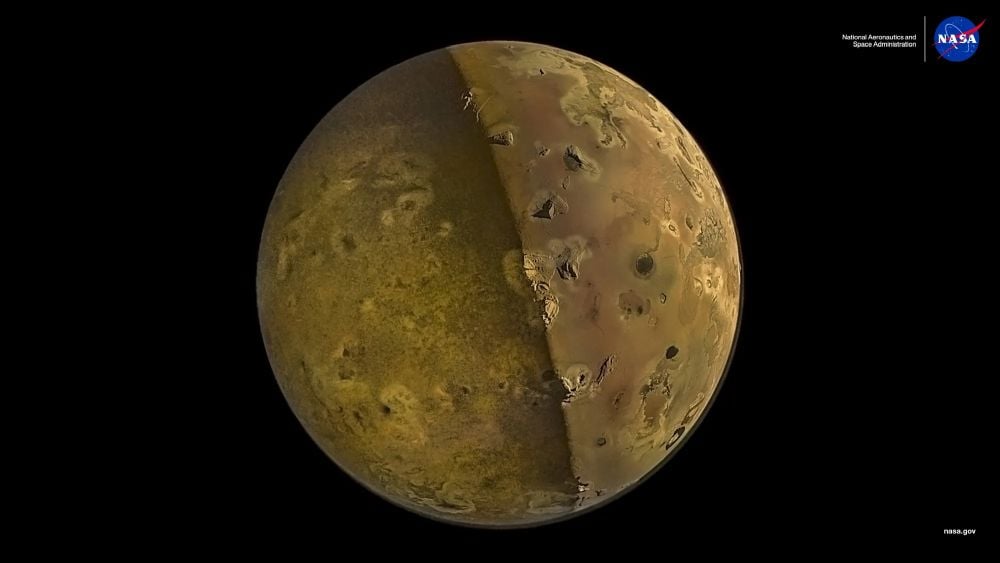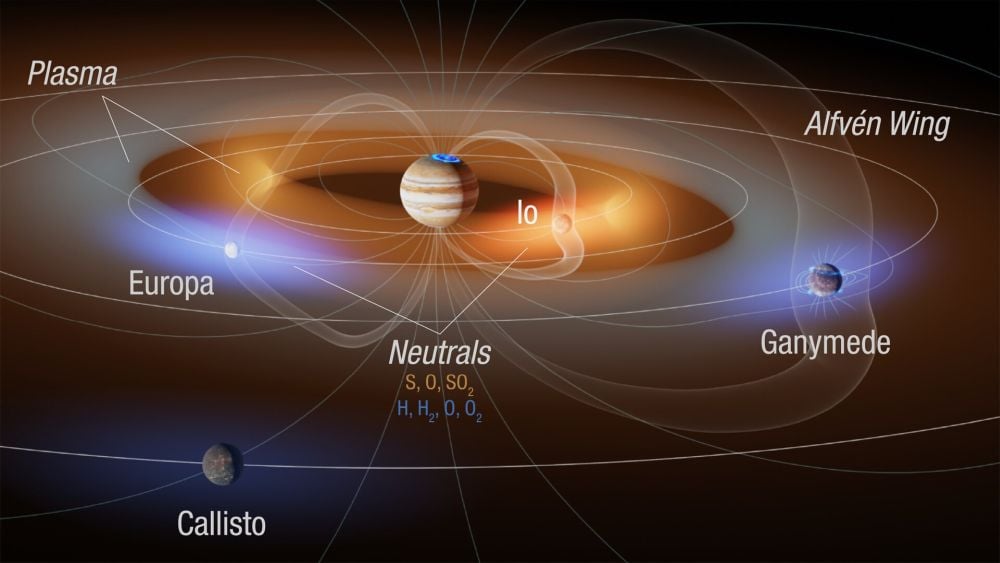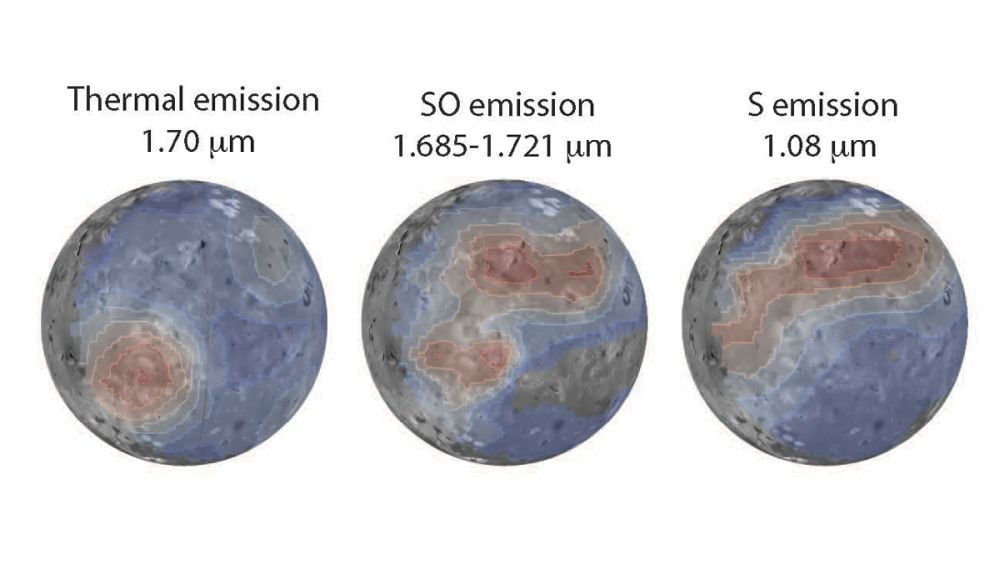Jupiter’s moon Io stands alone among the Solar System’s moons. It has more than 400 active volcanoes, and its surface is home to more than 100 massive volcanic mountains, some of which are taller than Mt. Everest. Its surface is painted and repainted with the sulphur-rich fallout from these volcanoes, coloring the moon in red, yellow, and orange hues. Vast lakes of lava—the largest of which is 200 km across—also dot its surface. All this on a world that’s only about one quarter as large as Earth.
Earth’s modest volcanism is fuelled by internal heat from a pair of sources: primordial heat left over from the planet’s formation, and heat from the radioactive decay of elements in the mantle and crust. But Io is in a much more precarious situation.
It’s caught in a tug of war. It’s pulled this way and that by the powerful gravitational force of Jupiter, and the combined gravitational effects of the three other Galilean moons, Callisto, Ganymede, and Europa. All of these powerful forces nearly overwhelm Io, repeatedly stretching and deforming the moon. This action heats Io up, creating and maintaining its intense volcanic nature.
 *This image of Io is NASA’s Science Calendar Image of the Month for October 2025. It was captured by JunoCam, the imager on NASA’s Juno spacecraft from about 1500 km above the surface. It reveals some of Io’s fascinating volcanic surface details. The right side (dayside) of the image is lit up by the Sun, while the left side (nightside) is illuminated by Jupitershine, sunlight reflecting from Jupiter back onto Io. Image Credit: NASA/Jet Propulsion Laboratory–Caltech/Southwest Research Institute (SwRI)/Malin Space Science Systems (MSSS); Image processing: Emma Wälimäki © CC BY*
*This image of Io is NASA’s Science Calendar Image of the Month for October 2025. It was captured by JunoCam, the imager on NASA’s Juno spacecraft from about 1500 km above the surface. It reveals some of Io’s fascinating volcanic surface details. The right side (dayside) of the image is lit up by the Sun, while the left side (nightside) is illuminated by Jupitershine, sunlight reflecting from Jupiter back onto Io. Image Credit: NASA/Jet Propulsion Laboratory–Caltech/Southwest Research Institute (SwRI)/Malin Space Science Systems (MSSS); Image processing: Emma Wälimäki © CC BY*
Researchers working with the JWST observed Io twice, in 2022 and 2023, to gather new information about this unique world. Their results are in new research in JGR Planets titled “First Detection of [SI] in Near-IR JWST Observations of Io in Eclipse, and Comparison With SO Emissions, Evolving Volcanic Eruptions, and Prior UV HST-STIS [SI] Emissions.” The lead author is Imke de Pater, an Astronomy Professor at UC Berkeley.
Like Earth and the other rocky inner Solar System bodies, Io’s crust and mantle are dominated by silica. But scientists rely on the tiny amount of sulphur present to reveal the Moon’s inner workings and to understand its volcanism. Sulphur is much rarer than other components of Io, but it likes to bond with things like iron and oxygen. When Io’s molten material bubbles to the surface, it carries sulphur with it, and the characteristics of the sulphur, like its abundance and its molecular form, reveal what’s happening underground.
Io’s volcanic activity means that its surface is in constant flux. The new images show that it’s largest lava lake, Loki Patera, formed a new crust, following a repeating pattern in the last couple of decades. Lava flows from a 2022 eruption in the moon’s Kanehekili region had spread to cover more than 4,300 sq km of the surface. The lava flow has expanded by 4x since then.
 *This figure shows some of the JWST’s images of Io. Each one is at a different wavelength, shown in the top left of each panel. “The image at 1.7 μm is taken at the center of the SO band (1.705–1.709 μm), and hence contains both thermal volcanic and SO emissions,” the authors write. “The latter is minute compared to the thermal emissions.” Image Credit: de Pater et al. 2025. JGR Planets*
*This figure shows some of the JWST’s images of Io. Each one is at a different wavelength, shown in the top left of each panel. “The image at 1.7 μm is taken at the center of the SO band (1.705–1.709 μm), and hence contains both thermal volcanic and SO emissions,” the authors write. “The latter is minute compared to the thermal emissions.” Image Credit: de Pater et al. 2025. JGR Planets*
These JWST observations were about more than the changing volcanic surface features. They’re part of an ongoing investigation between sulphur emissions and volcanic hotspots. As the study title says, this is the first time that scientists have detected [SI] on Io. [SI] is neutral sulphur atoms, and along with the detection of sulphur monoxide (SO), it opens a window into the conditions and processes that define the volcanic moon. Perhaps surprisingly, they also illustrate the moon’s contentious relationship with massive Jupiter.
As it turns out, the [SI] emissions don’t come directly from Io’s volcanoes. Instead, it comes from collisional excitation from electron impacts. Where do these electrons come from?
Io is basically enslaved to Jupiter. Jupiter’s not only far more massive than Io; it has an extremely powerful magnetosphere, too. A neutral cloud of atoms surrounds Io, and they become ionized by Jupiter’s magnetosphere and accelerated and carried along by it. This forms a torus of ionized atoms that orbits Jupiter at Io’s orbital distance. This is the source of the electrons that generates the [SI]. They slam Io’s atmospheric, volcanically-generated sulphur.
 *This schematic of Jupiter’s magnetospheric plasma environment (not to scale), shows the plasma torus around Jupiter and the neutral clouds around the moons. Electrons from the plasma torus create some of the sulphur signatures at Io rather than the Moon’s volcanism. Image Credit: B. Smithin Szalay et al. 2022. Geophysical Research Letters, 49, e2022GL098111. https://doi.org/10.1029/2022GL098111 – CC BY-SA 4.0*
*This schematic of Jupiter’s magnetospheric plasma environment (not to scale), shows the plasma torus around Jupiter and the neutral clouds around the moons. Electrons from the plasma torus create some of the sulphur signatures at Io rather than the Moon’s volcanism. Image Credit: B. Smithin Szalay et al. 2022. Geophysical Research Letters, 49, e2022GL098111. https://doi.org/10.1029/2022GL098111 – CC BY-SA 4.0*
This research validates some Hubble observations from 20 years ago. It demonstrates that despite Io’s intense and continuous volcanic activity, the moon’s atmosphere and the plasma torus are surprisingly stable.
The research also shows that SO molecules in an excited state come directly from volcanic vents, as they were detected over Kanehekili Fluctus, site of a recent eruption. This validates a 20 year old hypothesis from de Pater et al. This is called thermally-driven emission from volcanic outgassing, whereas the [SI] is from magnetospheric interactions. The thermally-driven SO is significant because it gives scientists a direct reading of how hot Io’s volcanic system is. It shows that Io’s volcanoes are violently powerful and very hot.
Taken together, the results show that Io’s atmosphere is being powerfully shaped by both volcanological and magnetospheric processes, both a result of its intense relationship with Jupiter. It’s the only body in the Solar System where these forces wield such enormous influence, another reason that Io is unique and worth studying.

